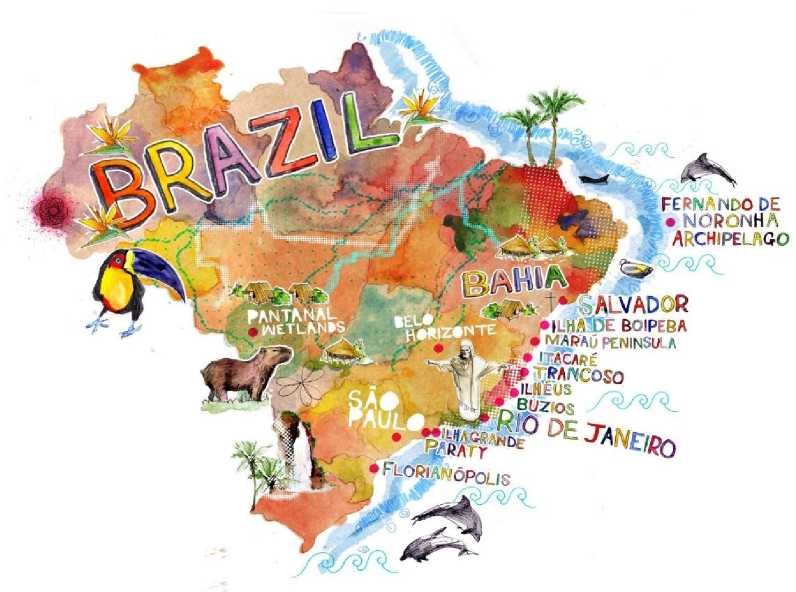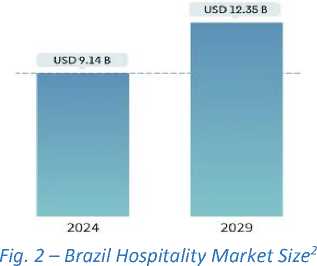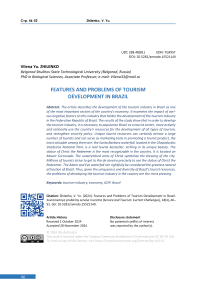Features and Problems of Tourism Development in Brazil
Автор: Vilena Yu. Zhilenko
Журнал: Современные проблемы сервиса и туризма @spst
Рубрика: Региональные проблемы развития туристского сервиса
Статья в выпуске: 4 т.18, 2024 года.
Бесплатный доступ
The article describes the development of the tourism industry in Brazil as one of the most important sectors of the country's economy. It examines the impact of various negative factors on this industry that hinder the development of the tourism industry in the Federative Republic of Brazil. The results of the study show that in order to develop the tourism industry, it is necessary to popularize Brazil as a tourist center, more actively and rationally use the country's resources for the development of all types of tourism, and strengthen security policy. Unique tourist resources can certainly attract a large number of tourists and can serve as marketing tools in promoting a tourist product, the most valuable among them are: the Santa Barbara waterfall, located in the Chapada dos Veadeiros National Park, is a real tourist bestseller, striking in its unique beauty. The statue of Christ the Redeemer is the most recognizable in the country. It is located on Mount Corcovado. The outstretched arms of Christ symbolize the blessing of the city. Millions of tourists strive to get to Rio de Janeiro precisely to see the statue of Christ the Redeemer. The Adam and Eve waterfall can rightfully be considered the greatest natural attraction of Brazil. Thus, given the uniqueness and diversity of Brazil's tourist resources, the problems of developing the tourism industry in the country are the most pressing.
Tourism industry, economy, GDP, Brazil
Короткий адрес: https://sciup.org/140309805
IDR: 140309805 | УДК: 338.48(81) | DOI: 10.5281/zenodo.15521140
Текст научной статьи Features and Problems of Tourism Development in Brazil
To view a copy of this license, visit

Дата поступления в редакцию: 1 октября 2024 г.
Дата утверждения в печать: 20 ноября 2024 г.
Introduction
Tourism in Brazil is an actively developing sector of the economy. Brazil is the most attractive country in South America, with about 8.5 million tourists visiting Brazil annually. The tourism industry is one of the main sources of income. Tourist flows to the country come from Argentina, the USA, Uruguay, Paraguay and Germany, Portugal, and Peru. The country has the necessary tourism and recreational resources for the development of ecological, historical, educational, business, and recreational tourism. Brazil's tourism potential is diverse, the country has rich natural resources: famous rivers and waterfalls, impassable equatorial and tropical forests, mountains, coral reefs, and rich wildlife. There are also famous historical and cultural sites and business centers on the territory of Brazil. An important factor influencing the development of recreational tourism is the favorable climatic conditions: the average temperature in summer (December-April) is about +24 0C, in winter (May-November) +22 0C [1]. The main centers of recreational tourism are located along the Atlantic coast, within the tropical climate zone. Despite the significant tourist potential of Brazil, there are also problems in the country that hinder the development of this sector of the economy. The relevance of the problems under consideration, their practical significance and the insufficient degree of scientific study determined the choice of this topic [2].
Methods
The methodological basis of the work was the socio-economic approach to the study of the state and development trends of inbound and domestic tourism in Brazil. The work used the methods of generalization, induction and deduction, system analysis, classification, statistical analysis.
Discussion of the results
According to the data, Argentina topped the list of countries sending the most tourists to Brazil, with 1.9 million visitors, or 32% of the total. The United States with 668,500, Chile with 458,500, Paraguay with 424,500 and Uruguay with 334,700 rounded out the top five countries sending the most tourists.
All tourist centers in Brazil can be divided into three different groups.
The first group includes tourist centers that represent the heritage of culture and values, where religious shrines are concentrated, centers of ethnographic industries, where various festivals and congresses are organized. The main tourist centers of Brazil that are included in this group are: Brasilia, Santa Luiz, Rio de Janeiro, Olinda, Ouro Preto, Recife, Salvador. This group of tourist centers attracts about 3 million visitors annually. Among the listed tourist centers, the most popular are Sao Paulo and Rio de Janeiro.
The second group includes tourism centers that were formed on the basis of natural values. Among the latter, there are beautiful water areas, rich hunting and fishing grounds, territories of the nature reserve fund, including national parks and reserves, natural landscapes, with ecological trails organized within them. Territories of an exotic nature also belong to this group. The tourist centers of this group include: "Sugar Loaf" (mountain) and about 62 National Parks of Brazil. The most visited national parks are "Amazonia", "Iguazu", "Pantanal", the Marine National Park of Fernado de Noronha. Also, a large number of tourists are attracted by the largest lagoon on the planet – Patus. In general, this group of tourist centers is visited annually by a slightly smaller number of tourists – 2.5 million.
The third group includes tourism centers that focus on recreational resources and includes areas of existing recreational and tourist cores and already established tourist areas and resorts. Coastal landscapes are especially favorable for recreational tourist centers. In Brazil, this group includes such tourist centers as: Recife, Angra dos Raines, Buzios, Rio de Janeiro, Diamantina, Curitiba, Petropolis, Costa de Sejupe, Ubatuba, Porto Alegre, Ita-care, Sao Luis, Fortaleza. In terms of popularity and attendance, this type of tourist centers is equivalent to the first group. The number of tourist flows here annually is approximately 3 million visitors. In general, ecological travel to the Amazon, Pantanal, Serra Tausha, Serra Fluminense are promising for the development of tourism in Brazil [5].

Fig. 1 – Brazil Attractions Ma p1
Brazil has a rapidly growing hospitality industry [6]. The hospitality industry in Brazil is segmented by type (chain hotels and independent hotels) and by segment (serviced apartments, budget and economy hotels, mid-range and upper-mid-range hotels, and luxury hotels). The market size and forecasts for the hospitality industry in Brazil are presented in value terms (in millions of US$) for all the above segments (Fig. 2).
The hospitality industry market size in Brazil is valued at US$9.14 billion in 2024 and is expected to reach US$12.35 billion by 2029, growing at a CAGR of 6.23% during the
1 Source:
forecast period (2024-2029). The increasing number of tourists and the rise in disposable income are the main drivers of the Brazilian hospitality industry. In typical locations of the country, such as Sao Paulo, Fortaleza, Brasilia, Recife, and Belo Horizonte, the industry has shown high growth rates. Various government initiatives to revive tourism after the pandemic are also one of the driving factors of the Brazilian hospitality industry.

The number of foreign tourists to Brazil has been steadily increasing. The main contributors to this trend were business travel, followed by leisure travel. Brazil received more than 6.6 million foreign tourists in 2019 [7]. The number of tourists coming to Brazil has been growing steadily for five years. However, the pandemic has affected the tourism industry and international tourism around the world has suffered. Last year, the industry experienced a recovery (Fig. 3).
Local and international brands and their chain hotels are almost equal in the total number of hotel properties they own in Brazil. The country also has a large number of independent hotels, family-owned and operated. The Brazilian branded and chain hotel market is mainly dominated by mid- to upper-midrange hotels, which account for almost 65% of the total market share. Both domestic and international brands are well represented in this segment, and most hotels are strategically located in important regions of the country.
The tourism industry in Brazil, in addition to its rapid development, has a number of problems. One of the reasons for Brazil's lack of demand is the lack of direct marketing of the country on the international market, which leads to the reinforcement of established stereotypes about Brazil as a place with a limited offer of tourist attractions, limited to samba and football.

Fig. 3 – International tourism in Brazil (2018-2024)2
Most of Brazil's territory is located in the tropical zone, and only its southernmost tip lies in the subtropical zone. The location in low latitudes causes a large amount of solar radiation in the country and high average annual temperatures, which vary from +14.7 to +28.3 °C. Such temperatures contribute to the spread and development of viruses (tropical mosquito-borne viral fevers). According to the Brazilian Ministry of Health, in 2024, 7,236 cases of Oropouche fever were registered in 20 states of Brazil. In addition, six cases of potential vertical transmission (from mother to fetus) of the Oropouche virus are being investigated. The country has introduced a regime of enhanced epidemic control for the virus, which is transmitted mainly through the bites of Culicoides paraensis midges. Symptoms of the fever are similar to those of dengue fever – a sharp increase in body temperature, headache, muscle pain, rash, joint pain and vomiting.
Earlier in January 2016, a massive outbreak of the Zika virus was registered in Brazil, which was declared a global threat to the Western Hemisphere by the World Health
2 Source:
Organization.
Tourists traveling to Brazil are afraid of crime. If we talk about what types of crime are most common in Brazil, then we should mention, first of all, street crime (which is mostly of a mercenary and violent nature) and violent crime, the victims of which are increasingly women, girls and girls. Corruption, organized and drug crime also create serious problems for the country [7].
Information on street crime in Brazil is often provided by various agencies of foreign countries warning their citizens about criminal risks in the countries they may travel to. An example is the American Overseas Security Advisory Council (OSAC), which prepares reports on crime and security in various countries and cities. In a report published in May 2020, the Advisory Council classified Brazil as a Level 2 country (Exercise increased caution), where increased caution must be exercised when visiting. Rio de Janeiro is described in the report as a very dangerous city in terms of crime (a “CRITICAL-threat location”). The most common crimes are murder, armed robbery, carjacking, assault, kidnapping, which are committed in any part of the city at any time of the year [8].
Brazil ended 2023 with the lowest level of intentional homicides since 2010, the Rio de Janeiro agency said in a statement. According to its data, more than 40,000 such crimes occurred in the country in just one year, with a 4% decrease. However, data from the UN Global Study on Homicide 2023 report indicate that Brazil ranks first in the world in terms of intentional homicides - 45,000 per year.
Conclusion
Thus, despite the significant tourist potential of Brazil, as well as its participation in such influential international institutions as the Organization of American States, BRICS, G-20 (The Group of twenty – Group of twenty largest economies in the world), MERCOSUR (translated from Spanish as “Market of the Southern Cone” – subregional trade and economic union), UNASUR (Union of South American Nations – Union of South American Nations), IBSA (international association consisting of India, Brazil and South Africa), CELAC (Community of Latin American and Caribbean States) in the development of the tourism industry there are also a number of restraining factors.
In turn, the restraining factors are:
-
- climatogenic conditions. Thus, some features of the tropical climate, as well as tropical mosquito viral fevers as a consequence, can be a test for foreign tourists;
-
- the presence of the largest volume of external debt in the world, as well as the maximum degree of inequality in income distribution;
-
- the safety of tourists and the safety of their health and life. Features of the flora and fauna of protected and wild areas of Brazil can be a test for inexperienced tourists, because in addition to predators, there are many poisonous plants, animals and insects;
-
- a high level of petty crime in large cities of the country. This is due to the presence of a large number of socially vulnerable citizens and the unemployed.
For stable and progressive development of adventure tourism in Brazil it is necessary:
-
- to popularize Brazil as a tourist center, which has the richest natural resources, has a unique cultural heritage, and is also distinguished by a high level of hospitality;
-
- more actively and rationally use the country's resources to develop all types of tourism, for example, by creating special organizations that are interested in promoting tours.
In addition, it is important to minimize the impact or eliminate the constraints, which is a complex process and requires a wide range of actions from the Brazilian government and the population. Thus, Brazil has prospects and resources for the development of such types of tourism as: business, sports, environmental, extreme. Brazil has objective prerequisites for transforming into one of the world centers of international tourism. This will be facilitated by rapid rates of economic growth and an increase in the well-being of the population.


